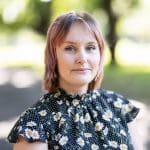Life’s a (research) journey

24 February 2023 at 1:18 pm
Childhood escapes to nature and youthful dabbles in not-for-profit work have guided Liana Downey’s path in climate activism. She is this week’s Changemaker.
“I consider my career a research journey on how to have impact — one that I’m still on!”
It’s been quite the journey for Liana Downey. She began her not for profit career early on in her university days, assisting international not for profit AIESEC “with the rather ambitious vision of ‘peace and the fulfilment of humankind’s potential’,” she explained.
She learned a valuable lesson from that experience.
“While it was inspiring to work with so many passionate people from around the world, I wasn’t always convinced that our impact matched up with our effort. That motivated me to learn how to do better, how to reliably drive impact. I set out to learn how the world really worked — how decisions got made, how resources got allocated, and what changed behaviour.”
Studying maths and computer science taught her the power of good data, while a Bachelor of Arts gave Downey insights into pattern recognition. An MBA at Stanford enhanced her skills in change management. But there was also on the job learning: she learned strategic problem solving at McKinsey & Company, and while running a strategic advisory firm for not for profits and governments, she honed her skills in setting an inspiring vision, tracking outcomes and taking an evidence-based approach to solving complex problems.
“I’ve benefited from working across different industries, countries, and sectors, in addition to roles in the corporate sector and nonprofits (including a stint as a turnaround CEO for a think tank),” Downey said.
She’s just wrapped up what she describes as “a mini-climate PhD’ working with Common Ground on Climate, where she interviewed more than 100 experts from around the world, reviewing, conducting and analysing research on “what people in Australia understand and think about climate, what work is underway, and what we’ll need to tackle climate change”.
It’s all led to the newest stop on her journey: as president and chair of the board of the Australian Conservation Foundation (ACF).
Where does your passion for climate action and the environment come from?
I’ve spent my life in cities, but always escaped to nature when I could. My childhood involved a lot of camping and the work of May Gibbs (Snugglepot and Cuddlepie), kickstarting a life-long love of gum blossoms. My paternal grandfather was a real bush-man, and my dad had trained as an agronomist, and together they would point out plants, fungus and lichens, and try to teach me all the botanical names on bush rambles. My mum was a country kid, and is an extraordinary gardener, a trained illustrator who uses flowers as a canvas, and both her parents had very green thumbs. Her dad was a farmer, and ahead of his time — protecting a plot of trees on their land with nesting eagles.
While I’d say I’ve been very lucky compared to lots of other families, I’ve also been exposed to a fair share of adverse-weather events — a family member lost their Canberra house to bushfire, then ten years later to the day, our extended family was forced to evacuate from another fire in Nowra. In one year I was holed up in a Darwin cyclone, then two big hurricanes in New York, including sitting in the eye of Hurricane Sandy. I’m still dealing with insurance claims from the Sydney floods. That certainly sharpens the mind.
Do you have any plans for your role as president and chair at ACF, what would you like to achieve?
The ACF has already played a substantial role in safeguarding our environment, and I’m keen to help further that. My role is clear — it’s to lead the board in providing effective governance to help the Australian Conservation Foundation achieve its vision of an Australia where nature and people thrive, while ensuring effective risk management and stewardship of resources.
My background is in working with not for profit boards, CEOs and executives to help them increase their impact, and I look forward to bringing those skills to bear in support of the ACF.
What do you see as the biggest challenges facing ACF and the climate movement in general?
We have three big challenges:
- First, addressing climate change requires innovation, planning and coordination on a scale the world has not seen before.
- Second, in Australia, because we’ve been such large producers and exporters of coal and gas, we’ve been slow to act. We are playing catch up with most developed economies with respect to building out our policy framework and renewables capacity, and we have knowledge, capacity and skills gaps as a result.
- Third, we’re now living with the impacts of climate change — fires, floods and dislocated communities — while trying to reform our economy.
It’s a lot.
What that means for ACF and the climate movement is that now more than ever, we have to come together with unlikely partners. We can’t just fold our arms and say to someone else, “fix it”. There’s no time to point the finger, and we can’t let the perfect be the enemy of the good. We have to keep moving forward and engaging in the practical questions of how we will reform our economy. Fortunately, this is one of ACF’s real strengths — pragmatic engagement with a broad range of partners.
Climate and environment policy in Australia has been bogged down in recent years and is often subject to pretty nasty debate and misinformation. How do you stay positive and hopeful in the face of this?
Since positivity is critical to achieving change, it’s great that there is a lot to be positive about. The economics have shifted dramatically. Unsubsidised new solar and wind are now cheaper than coal. That’s driving a lot of change. Nature laws are getting stronger all around the world. New international global reporting standards on climate are just about to come in place, which will have huge flow-on impacts. There’s loads of community-level engagement and change happening all around the country, invigorating democracy. Plenty of big companies have stopped waiting for governments and are setting their bold serious aspirations. There are masses of innovations emerging all the time — solar panels that look like glass, more efficient wind turbines, cheaper electric vehicles, more efficient forms of storage. Rapidly emerging AI may help us speed up the innovation we need to convert our economy. Humans are very good at rising to a challenge — I have a lot of optimism about what is possible.
What are you most proud of in your extensive, and busy, career?
I’m proud of the teams I’ve led and worked with, and the leaders and clients I’ve served, and the impact they’ve had. Some that come to mind are: reinstating traditional land management practices leading to reduced emissions and improved biodiversity outcomes (numerous different indigenous communities working across NT and QLD); improving health and education outcomes for indigenous families (Children’s Ground); housing more than 100,000 people who’d been homeless for more than 10 years and ending functional veterans homelessness in cities all across the USA, (Community Solutions); improving health and educational outcomes for thousands of kids across New York (Room to Grow); improving outcomes for kids by rolling out trauma-informed practices to thousands of educators in NSW (NSW Education). I could go on — I’ve been lucky to work with so many amazing organisations and leaders driving real impact in their communities.
How will you balance your role at ACF with your other roles?
Because all my work is focussed on climate and sustainability, there are a lot of synergies. Work in one area supports work in another.
In practical terms I plan my time pretty carefully, working hard to focus on priorities, leverage my colleagues and do my best not to get bogged down in minutia.
How do you wind down at the end of the week?
My favourite thing to do is spend time with family and friends. We live close to the bush — I love a long bushwalk, or a visit to the beach with family or friends, with a snack along the way. I also run and play the piano. A long run and an hour or two in front of the piano allow me to switch my brain into a very different place. Netflix is my guilty pleasure, I like going down rabbit holes of Korean and Swedish comedy/dramas.
What would you like your legacy to be?
My dream is to help shift our economy to a circular one. I’d love to play a role in sorting out our economic incentives so that we price pollution and value our natural assets properly. There is a clear link between the incentives people have and how they behave. Sort out the incentives and good things happen. We’ll know we are getting close when we see some extra columns in the back of The Economist with metrics like biodiversity, water quality, percent of protected land, alongside the country-level GDP and inflation figures.
It can feel like a pipedream, but there are plenty of societies on Earth where this has been the case (Indigenous communities in particular) — we just need to find a way to bring together our current love of innovation and growth with some sensible boundaries on resources.
I’d also like to see my two kids become happy healthy adults making the world a better place.







